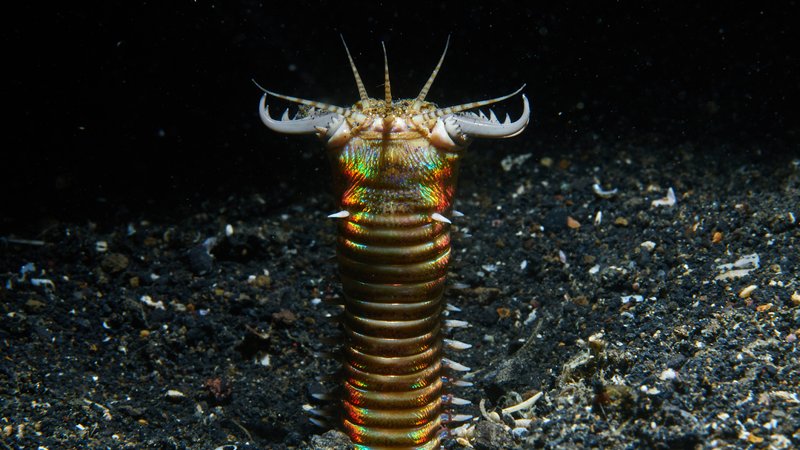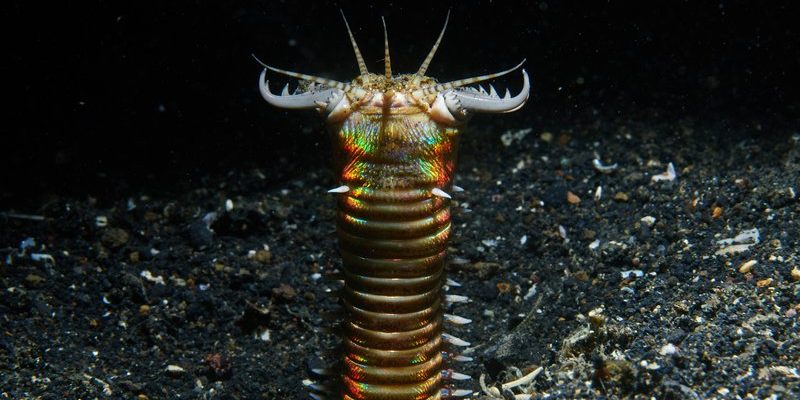
So, just how deep do these creatures burrow in the sand? If you’re picturing a simple hole in the ground, think again! Bobbit worms can dig incredibly deep, turning the ocean floor into a unique habitat. Let’s explore their burrowing habits, what they do down there, and why it matters.
Understanding Bobbit Worms
Bobbit worms, known scientifically as *Eunice aphroditois*, are marine polychaete worms that can grow up to 10 feet long. Yes, you read that right! They may seem unassuming at first, living in sandy environments, but they are fierce hunters. With their long, segmented bodies and powerful jaws, bobbit worms are known for quickly snapping up unsuspecting fish and crustaceans that wander too close.
These worms primarily reside in tropical and subtropical waters around the globe. Their burrowing behavior not only provides them safety from predators but also helps maintain the health of the ocean floor’s ecosystem. They create intricate tunnels in the sand, which can be beneficial for other marine life.
Bobbit Worm Burrowing Depths
Now, let’s get into the nitty-gritty of how deep bobbit worms can actually burrow. Generally, their burrows can reach depths of **several feet**, depending on the conditions of their habitat. While some reports suggest they can dig up to 10 feet deep, most commonly, they create burrows of about **3 to 6 feet**. That’s pretty impressive for a creature that looks like a worm!
The depth of their burrows can be influenced by multiple factors, like sediment type, water temperature, and the presence of other organisms. Sandy substrates allow these worms to burrow more easily, while rocky or hard surfaces might limit their progress. You might be wondering why they go so deep—well, that’s where most of their food is, and it keeps them safe from predators!
How Bobbit Worms Construct Their Burrows
Building a burrow is no simple task for a bobbit worm. They use their powerful muscles to dig through the sand and create a cylindrical tunnel. These tunnels serve multiple purposes: they’re hiding spots, feeding grounds, and breeding areas.
Here’s how it works:
- Diving In: The worm pushes its body down into the sand, using its bristly appendages to grip and pull soft sediment towards it.
- Shape Matters: The burrow is usually U-shaped, allowing the worm to stay hidden while still having access to catch prey.
- Creating an Entrance: While they dig, the worms also maintain an opening on the surface, which serves as a trap for unsuspecting fish.
This intricate construction is both practical and strategic. The bobbit worm’s ability to craft such effective burrows is essential for its survival.
The Role of Bobbit Worms in the Ecosystem
Bobbit worms are more than just interesting creatures; they play a vital role in marine ecosystems. By burrowing into the sand, they help aerate it. This process increases the availability of oxygen, promoting the growth of other organisms that live in the sand.
Additionally, their feeding habits contribute to nutrient cycling. As they capture prey and consume organic material, they break down nutrients that return to the ecosystem. This is crucial for maintaining the balance of life in their sandy homes.
So, while they might seem like simple creatures, bobbit worms have significant impacts on their environment. They’re like tiny gardeners of the ocean floor!
Predators and Threats to Bobbit Worms
While bobbit worms are adept at hunting and hiding, they’re not without their enemies. Various marine predators, including fish and crabs, are known to target them. However, their burrows offer substantial protection. It’s a bit like having a secret hideout where they can escape from danger.
You might be curious about how they respond to threats. When startled, bobbit worms can retreat deep into their burrows, using their strong muscles to move quickly and evade predators. They are not easily deterred, which is impressive given their size!
However, their limited range and specific habitat needs make them vulnerable to environmental changes. Factors like pollution, climate change, and habitat destruction can pose serious threats. Preserving their environments is essential for their survival.
Curiosities About Bobbit Worms
Beyond their burrowing habits and ecological roles, bobbit worms have some other intriguing traits. For one, they have vibrant, colorful bodies that can be quite the sight! Typically, they come in shades of red, green, and brown, which helps them blend into their sandy surroundings.
Another fun fact is that they’re known for their unique hunting technique. Instead of actively chasing down prey, they lie in wait and quickly strike with their powerful jaws when something passes by. This ambush strategy is effective for catching fish, which can be quite the surprise for anyone who isn’t aware of their presence.
Oh, and here’s the kicker—some aquarists keep bobbit worms in tanks, but be warned! Their predatory nature means they might take a bite out of other tank inhabitants. So, if you’re considering adding one to your aquarium, be sure you know what you’re getting into!
How to Observe Bobbit Worms
So, you’re intrigued and want to see these incredible worms for yourself? Observing bobbit worms is not as straightforward as heading to the beach. They tend to remain hidden in their burrows most of the time. However, there are a few ways you can catch a glimpse of them:
- Snorkeling or Diving: If you’re in tropical waters, you might find them while exploring coral reefs or sandy bottoms.
- Aquarium Exhibits: Some aquariums feature bobbit worms in their displays, showcasing their unique behavior for visitors.
- Research and Education: Participating in marine biology programs can provide opportunities for close-up encounters with these fascinating creatures.
If you do get the chance to see a bobbit worm in action, take a moment to appreciate its beauty and cunning. It’s a reminder of how diverse and fascinating our oceans really are!
Bobbit worms might seem like unsung heroes of the ocean floor, but their burrowing ways and predatory skills make them crucial players in marine ecosystems. They dig deep into the sand, creating homes that support not just themselves but a whole host of other marine life.
Understanding how deep bobbit worms burrow helps highlight their unique adaptations and the important roles they play in their environment. As we learn more about these incredible creatures, we can better appreciate the complexity and beauty of the underwater world. So, next time you think of worms, remember that some of them are lurking beneath the waves, waiting to surprise you!

